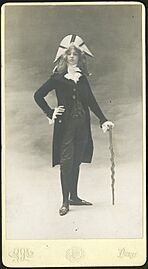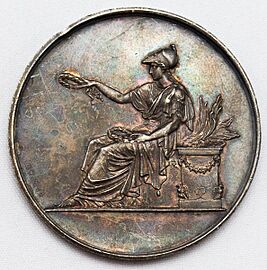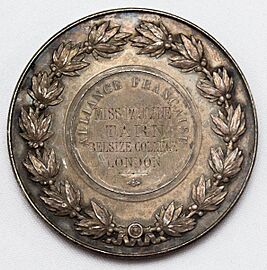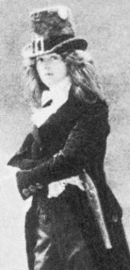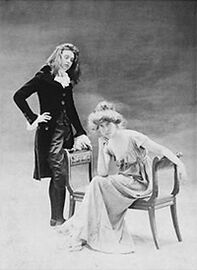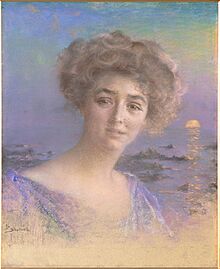Renée Vivien facts for kids
Quick facts for kids
Renée Vivien
|
|
|---|---|
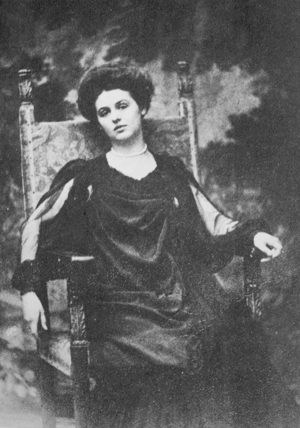
Renée Vivien, circa 1905
|
|
| Born |
Pauline Mary Tarn
11 June 1877 London, United Kingdom
|
| Died | 18 November 1909 (aged 32) Paris, France
|
| Resting place | Passy Cemetery, Paris, France |
| Monuments | Place Renée Vivien, Paris, France |
| Occupation | Poet |
| Era | Belle Epoque |
| Partner(s) | Violet Shillito (-1900)
Natalie Barney (1900-1901) Hélène van Zuylen (1902-1907) |
| Signature | |
 |
|
Renée Vivien (born Pauline Mary Tarn; 11 June 1877 – 18 November 1909) was an important British poet from the early 1900s. She wrote all her poems in French. Her writing style was influenced by the Symbolist and Parnassian movements. Many of her poems were about her own life and feelings, often showing deep emotions. Besides poetry, she also wrote other books, like L'Etre Double, and started a book about Anne Boleyn. Many books have been written about her life.
Contents
Biography
Early life and inheritance
Renée Vivien was born as Pauline Mary Tarn in London, England. Her father was a rich British man named John Tarn, and her mother was Mary Gilett Bennett from America. Her father made his money from buying and selling properties.
In 1883, when she was attending Belsize College in London, she won a silver medal from the Alliance française for her French studies. When her father passed away in 1886, Vivien was going to school in Paris. She returned to London and found that she had inherited her father's wealth. She then lived under the care of the court until she became an adult. In 1899, after turning 21, Vivien went back to France with her inheritance. Around this time, she started to be known as Renée Vivien.
World travels and home
Vivien was very educated and traveled a lot, which was unusual for women of her time. She spent winters in Egypt, visited China, and explored many parts of the Middle East. She also traveled across Europe and America.
In 1907, Vivien traveled to Japan and then Hawaii with her mother. She became ill during this long journey.
Her home in Paris was a fancy apartment with a Japanese garden. She filled it with old furniture from London and unique art from the Far East. Her home always had fresh flowers and special offerings to her collection of shrines and Buddhas.
Today, a public square in Paris is named in her honor: Place Renée-Vivien, located in the historic Le Marais area.
Death
Renée Vivien passed away in Paris on 18 November 1909. She was 32 years old. At the time, her death was reported as "lung congestion."
Works
Published works
Renée Vivien wrote only in French. Some of her works have been translated into other languages.
Her first book of poems, Études et préludes, was published in 1901. She went on to publish 12 more poetry collections during her lifetime. She also translated the ancient Greek poet Sappho's verses into French. She even learned Greek just so she could read Homer in the original language.
In 1903, Vivien published her translation of Sappho's poetry, called Sapho, traduction nouvelle avec le texte grec. In 1904, she published A Woman Appeared to Me, which was a novel about her own life. This book was later translated into English in 1976. Another one of her poetry collections, The Muse of Violets, was translated into English in 1977.
Vivien also wrote poems and stories with her friend Hélène van Zuylen. They used the pen name Paule Riversdale. Some experts believe that Vivien might have written these works mostly by herself.
During her short life, Vivien wrote a lot of poetry. She was known as the "Muse of the Violets" because she loved these flowers so much. Her strong interest in violets and the color violet reminded her of her childhood friend, Violet Shillito.
Vivien followed the styles of Parnassianism and Symbolism in her writing. Her poems included different forms like sonnets and prose poetry.
Most of her poems are like a secret diary, written in French, and many have not been translated into English. Some of her main poetry books include Cendres et Poussières (1902), La Vénus des aveugles (1903), and Dans un coin de violettes (1909).
Her poetry has become more popular recently, especially because people are rediscovering the works of the ancient Greek poet Sappho.
Gallery
-
Renée Vivien (left) and Natalie Clifford Barney posing for a portrait in Directoire-era costume
-
Lucien Lévy-Dhurmer (b. 1909), Portrait of Renée Vivien
See also
 In Spanish: Renée Vivien para niños
In Spanish: Renée Vivien para niños


